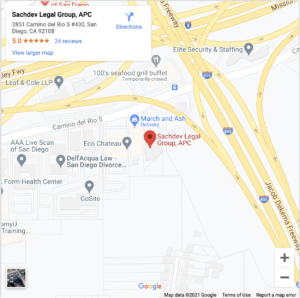Puja Sachdev | February 1, 2021 | California Law
A Request for Orders (RFO), also sometimes called an “order to show cause,” is the document used to ask the court clerk to set a hearing before the judge. The RFO also asks the judge to make certain orders after the hearing, based on the evidence presented at the hearing.
What Is an Order to Show Cause?
Legal terms have always been more formal than casual conversation. An “order to show cause” describes the paperwork issued by the judge that requires an opposing party to come to court on a specified date and time to “show cause” why the orders requested by the other party should not be entered.
Over time, the paperwork an attorney used to ask the court to set this hearing became known as an “order to show cause.” Since the judge is making the order, and not the party asking the court to do so, the more accurate name “Request for Orders” has been adopted.
What Happens When You File a Request for Orders in California?
In family law cases, like divorce matters, there are often a multitude of issues relating to the family that need to be resolved. While the ultimate goal of the case is to obtain a judgment of divorce, the court may need to make decisions relating to other matters as well.
To formally start the process, a party files the RFO to ask the court to set a hearing and make a decision. The court clerk will schedule a hearing date and prepare a copy of the RFO for service. After the RFO is filed, it must be served on the opposing party.
Service of process describes the formal delivery of legal paperwork to the person who is being sued. In most cases, the sheriff’s office makes service. If a party dodges service, a process server may need to be hired.
What Types of Issues Are Included in a Request for Orders?
The RFO can ask the court to address many kinds of issues, depending on the needs of the case, including whether the divorce is pending or finalized.
Usually, domestic violence orders are handled by a different, expedited process. Anyone whose life is in danger or is at risk of serious bodily injury at the hands of a family member should not hesitate to reach out to the National Domestic Violence Hotline.
In cases where the parents are not married, various issues may be resolved with a request for orders. For example, the RFO can be used to handle:
- Requests for paternity tests
- Requests for drug tests
- Child support
When parents cannot agree on child custody arrangements on their own or through mediation, the court can also decide child custody on a request for orders.
The RFO may be used to ask the court to handle different issues in a divorce case. Some issues that might be resolved in a divorce include:
- A determination of the validity of prenuptial or postnuptial agreements
- Spousal support
- Child custody evaluation (also available in non-divorce custody cases)
Before your hearing on these issues, you will need to gather all the evidence required to prove your case to the court.
Who Has To Convince the Court at the Hearing on the Request for Orders?
Usually, the party requesting the court to issue an order has the burden of proof to convince the court of their version of the facts. In some cases, a party may only need to make a prima facie showing of fact, after which the other party will have to defeat the original claim.
Prima facie is Latin for “on its face.” In court cases, it means that a party must present a minimum amount of evidence to prove their case in the absence of any contradictions. Once a prima facie case is established, it is up to the opposing party to contradict the claim.
For more information, call our law firm at (619) 866-3756 or reach out to us via email by visiting our contact us page.
